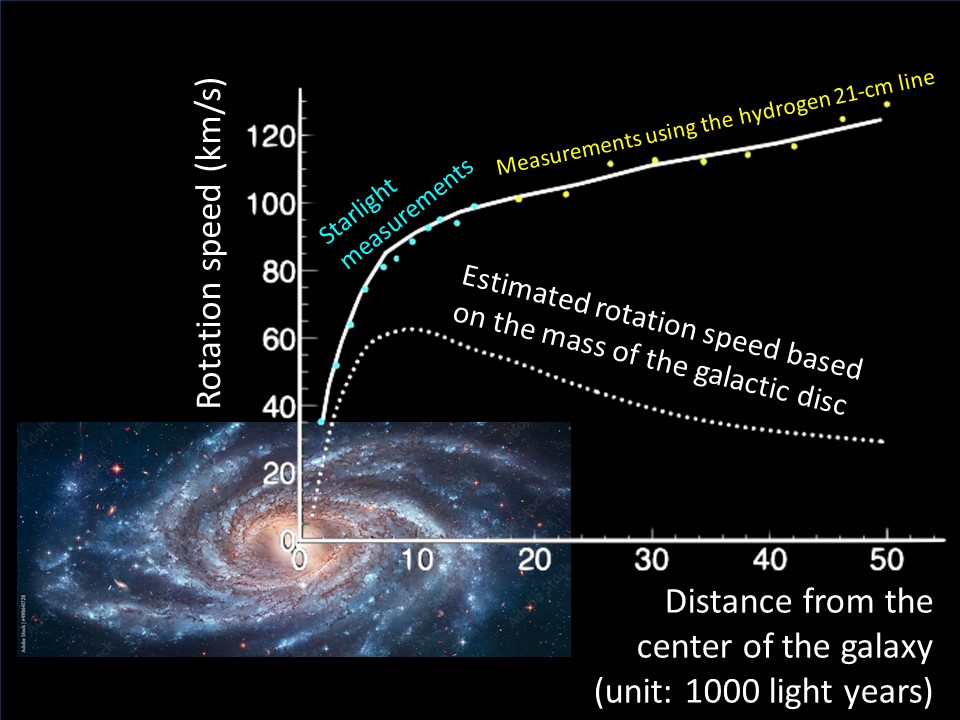
What is the nature of the most common matter in the universe?
Shigetaka Moriyama
(Professor, Institute for Cosmic Ray Research)
More than 80% of the matter in the universe is dark matter, an unknown substance that is neither atomic nor molecular, and scientists have been working hard to reveal its true nature since the first hints of its existence in 1933. Understanding dark matter would open the door to the physics of the “background” of the universe, and recent advancements have brought scientists closer and closer to solving the mystery.
Let us look at some examples of data indicating the existence of dark matter. Figure 1 shows the observed rotation speed of galaxies. When a galaxy rotates, the motion of each object should be balanced by the centrifugal force due to the rotation and the centripetal force due to the gravity of stars and gases inside the orbit. However, the observed rotation speed (individual data points and solid line) is much higher than the estimated rotation speed based on the gravity of the stars and gases inside the orbit (dotted line), which implies that the gravitational field is overpowered by a mysterious matter other than the stars or gases. Such inexplicable phenomena exist at various scales in the universe, but assuming a single type of dark matter resolves the incongruities in one fell swoop.
If dark matter is an elementary particle, it must have been produced and existed in the early universe. If so, scientists should be able to detect it by methods other than gravitational interactions, revealing its true nature. To make it more of a challenge, the mass of dark matter particles is unknown, and its interaction with “ordinary” matter is weak. Therefore, researchers need to construct suitable measuring devices and observational methods. Probing thoroughly in regions where theory suggests probable observations and probing broadly in regions without such preconceptions are both crucial. Many such detection projects are underway.
Precise observations of the cosmic microwave background that began in the 1990s have also confirmed the existence of dark matter. At the time, “weakly interacting massive particles” (WIMPs) and “axions" were already recognized as two major candidates. Axions are expected to solve the strong CP problem in particle physics. Since then, scientists have been busy searching for evidence of dark matter in data gathered from particle accelerator experiments and astronomical observations. To detect dark matter directly in a laboratory, experimenters use highly sensitive dark matter detectors to look for evidence of interactions such as dark matter collisions. Figure 2 shows the upper limit of the scattering cross-section (proportional to the probability of collision) between WIMPs and ordinary matter (nucleons). Although the scattering cross-section of WIMPs is unknown, covering the possible region in depth in the next ten years or so is expected to lead to great discoveries.


Top: Observation of the rotation speed of a galaxy. The rotation speed is much higher than that estimated rotation speed based on the mass of the galactic disk, which is composed of stars and gas. This suggests the existence of invisible dark matter.
Bottom: The history and future of the sensitivity of the WIMP dark matter search. In the large-scale dark matter search experiment (photo) that the author is participating in, a large amount of liquid xenon is used as a target, and the measuring device is used to detect any light emission resulting from dark matter collisions. In the next 10 years or so, we aim to specify the possible scattering cross-section of WIMPs and conclude whether WIMPs are the true constituents of dark matter or not.
On the other hand, a wide range of possibilities has garnered attention recently, including dark matter lighter than WIMPs and dark matter as heavy as astronomical objects. Based on novel ideas, innovative observational instruments, and observational data, major discoveries may very well be possible. It is vital to keep generating new ideas and to carry out experiments. When I was in graduate school, my supervisor used to ask the students, "What is your idea today?” Ideas and persistence get dark matter research done.


